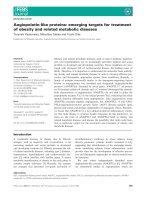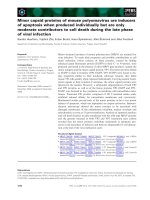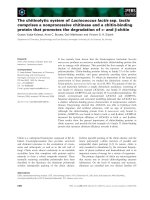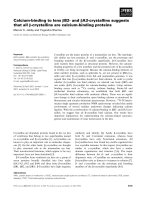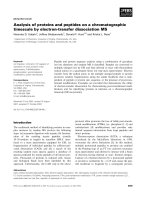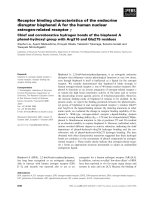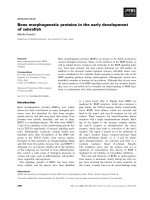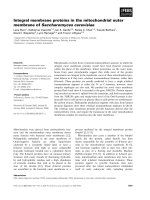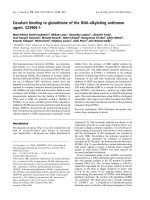Báo cáo khoa học: Alternative binding proteins: Affibody binding proteins developed from a small three-helix bundle scaffold potx
Bạn đang xem bản rút gọn của tài liệu. Xem và tải ngay bản đầy đủ của tài liệu tại đây (293.71 KB, 9 trang )
MINIREVIEW
Alternative binding proteins: Affibody binding proteins
developed from a small three-helix bundle scaffold
Per-A
˚
ke Nygren
Department of Molecular Biotechnology, School of Biotechnology, Royal Institute of Technology (KTH), Stockholm, Sweden
In several areas of life science, including biosepara-
tion, diagnostics, imaging and therapy, the availability
of reagents capable of the selective recognition of a
predefined analyte or target structure is critical. Until
the mid - 1990’s, such reagents were traditionally
immunoglobulin-based, consisting of either polyclonal
sera or monoclonal antibodies generated towards the
target analyte through immunization of laboratory
animals. However, recent advances in methodology
for the generation and handling of large and complex
libraries of various biomolecules [1], have led to a
development of new means for obtaining affinity
reagents of different types. Antibodies, as well as
non-immunoglobulin-based affinity reagents of differ-
ent classes (both protein and nucleic acid-based), can
now routinely be identified via functional selection or
screening from libraries of different types for their
ability to bind to a desired target structure under
defined conditions [2,3]. These novel reagents, typi-
cally built from frameworks that are smaller and
structurally less complex than immunoglobulins, are
expected to offer advantages related to both produc-
tion and application issues [4]. The topic of this
review is the so-called affibody binding proteins, an
example of the new emerging classes of protein-based
affinity reagents based on frameworks other than the
Keywords
affibody binding proteins; affinity
chromatography; combinatorial protein
engineering; in vivo imaging; peptide
synthesis; phage display; protein chips;
protein–protein interactions; selection; viral
retargeting
Correspondence
P A
˚
. Nygren, Department of Molecular
Biotechnology, School of Biotechnology,
Roslagstullsbacken 21, AlbaNova University
Center, Royal Institute of Technology (KTH),
SE-106 91 Stockholm, Sweden
Fax: +46 85537 8481
Tel: +46 85537 8328
E-mail:
(Received 16 November 2007, revised 11
February 2008, accepted 2 April 2008)
doi:10.1111/j.1742-4658.2008.06438.x
In recent years, classical antibody-based affinity reagents have been
challenged by novel types of binding proteins developed by combinatorial
protein engineering principles. One of these classes of binding proteins of
non-Ig origin are the so-called affibody binding proteins, functionally
selected from libraries of a small (6 kDa), non-cysteine three-helix bundle
domain used as a scaffold. During the first 10 years since they were first
described, high-affinity affibody binding proteins have been selected
towards a large number of targets for use in a variety of applications, such
as bioseparation, diagnostics, functional inhibition, viral targeting and
in vivo tumor imaging ⁄ therapy. The small size offers the possibility to
produce functional affibody binding proteins also by chemical synthesis
production routes, which has been found to be advantageous for the
site-specific introduction of various labels and radionuclide chelators.
Abbreviations
ABD, albumin-binding domain; Ad5, adenovirus type 5; Ab, amyloid-beta; DOTA, tetraazacyclododecane tetraacetic acid; DTPA,
diethylenetriane pentaacetic acid; FRET, fluorescence energy resonance transfer; gp120, glycoprotein 120; SPA, staphylococcal protein A;
SPPS, solid-phase peptide synthesis; T
m
, melting temperature.
2668 FEBS Journal 275 (2008) 2668–2676 ª 2008 The Author Journal compilation ª 2008 FEBS
immunoglobulin fold. This class of small (6 kDa)
affinity proteins was first described 10 years ago [5]
and since then affibody molecules have been devel-
oped towards many targets and have been used in
several different affinity technology applications.
The history of affibody proteins starts with staphylo-
coccal protein A (SPA), which is a familiar reagent to
most researchers working with immunotechnology or
related topics. Various native and recombinant vari-
ants of this natively cell wall-anchored immunoglobu-
lin-binding [Fc binding (IgG) and Fab binding
(VHIII)] bacterial receptin have, for several decades,
been widely used for the detection and purification of
antibodies from different sources. In addition, various
portions of the SPA gene, containing a region encod-
ing five highly homologous Ig-binding domains, have
also been frequently used as affinity gene fusion part-
ners for the production and selective purification
(IgG-affinity chromatography) of recombinant fusion
proteins [6]. The framework (or scaffold) upon which
affibody binding proteins are based is the so-called
Z domain, an engineered variant of a consensus SPA
domain (domain B). During the engineering process, a
few changes were introduced to facilitate directional
head-to-tail polymerization at the gene fragment level
and to increase the chemical stability of the protein
towards hydroxylamine (via a Gly to Ala substitution
simultaneously resulting in a loss of the Fab-binding
capacity) [7,8]. This three-helix bundle Z protein is
small (58 amino acids), composed of a single polypep-
tide subunit capable of rapid and independent folding,
devoid of cysteine residues, has a native capability of
high-affinity interaction with binding partner proteins
via a defined set of surface-located residues, and can
be easily expressed in soluble and proteolytically stable
forms in various host cells on its own or in fusion with
other protein partners [6]. Inspiration from advances
in protein library technology, and coinciding frustra-
tion caused by the unsuccessful prokaryotic production
of several cloned antibody-derived constructs in the
home laboratory, led to the decision to explore if the
advantageous features of the Z domain could be
employed for the generation of a novel class of affinity
reagents. The driving hypothesis was that the native
binding specificity for Fc of IgG, via amino acid sub-
stitutions at the involved face of the molecule, could
be switched to any other protein target of interest
while simultaneously retaining most, if not all, the ben-
eficial features of the ancestral Z-protein scaffold.
Examples from the selection, characterization and use
of target binding affibody proteins in different appli-
cations show that these assumptions have now been
verified in practice.
Library design and selections
Using combinatorial protein engineering principles,
so-called naive (or unbiased) libraries of candidate
affibody binding proteins have been constructed
through the genetic randomization of 13 surface-
located positions of the Z-protein-domain scaffold.
The choice of positions to include was based on anal-
ysis of an available X-ray crystallography structure of
the co-complex between the homologous B-domain of
SPA and human IgG [9]. The positions chosen were
all located to helices 1 (seven positions) and 2 (six
positions) of the three-helix bundle structure and
include most of the positions involved in the interac-
tion with the Fc region of human IgGl (hIgG1), but
also a few additional surface-located positions at the
same face of the Z domain [10] (Fig. 1A–C). Using
NN(G ⁄ T) degenerate codons at those position (as in
the libraries denoted Zlib-1 [10] and Zlib2002 [11],
including 32 codons in total and all 20 amino acids),
the theoretical diversity obtained is 32
13
(3.7 · 10
19
)
genetic variants encoding 20
13
(8.2 · 10
16
) different
protein variants. Owing to limitations related to the
efficiency of cell transformation during the construc-
tion of libraries, only a fraction (typically 10
7
–10
9
clones) of the theoretical complexity has hitherto been
searched in any selection experiment using a naive
library of affibody proteins. However, in efforts to
increase the affinities obtained for ‘first generation’
affibody binding proteins selected from naive libraries,
secondary libraries involving a more in-depth search
of a local volume of the entire structure space have
been constructed and used for selections (‘affinity
maturation’). Here, either all previously randomized
positions in an entire helix segment (‘helix shuffling’),
or a number of positions distributed between both
helices of a ‘first generation’ affibody molecule, have
been genetically rerandomized followed by new
rounds of stringent selections [12–14].
Hitherto, all reported de novo selections of affibody
binding proteins have been performed using phage
display technology based on standard phagemid
vectors and selection protocols. Alternative selection
systems are also being investigated, including
b-lactamase-based protein fragment complementation
assay [15], staphylococcal display [16,17], microbead
display [18] and ribosomal display (S. Grimm and
P A. Nygren, unpublished results). Affinities
obtained for different targets are similar to those
obtained for naive libraries of antibody fragments or
alternative scaffolds, with dissociation constants (K
D
)
ranging from micromolar to low picomolar, depend-
ing on library complexity and target structure
P A
˚
. Nygren Affibody binding proteins
FEBS Journal 275 (2008) 2668–2676 ª 2008 The Author Journal compilation ª 2008 FEBS 2669
characteristics. The highest affinity reported to date
for an affibody molecule is 22 pm for an affinity-
matured variant directed to the breast cancer marker
ErbB2 (Her2) [14].
Structural and biophysical analyses of
affibody proteins
An interesting question is if binding sites and fine-detail
epitopes (generally preferred by affibody binding pro-
teins developed via in vitro selection) differ compared
with epitopes seen by other binding protein classes,
including immunoglobulins generated via immuniza-
tions or library technology. The interaction surface
made up by the two randomized alpha-helices could be
regarded to differ significantly from the corresponding
surface in immunoglobulins, which is primarily made
up from contributions from six variable peptide loops.
However, in some instances efforts to roughly map the
epitopes via binding competition studies using mono-
clonal antibodies have shown the existence of at least
overlapping epitopes for these two different classes of
affinity reagents, also generated via different routes
[13,19–21]. Data from the structures of two different af-
fibody protein::target protein complexes (Z
SPA-1
::Z
WT
,
anti-Z
Taq
::Z
Taq
), from both NMR and X-ray crystral-
lography experiments, has provided detailed informa-
tion on the mode of binding and the interface involved
in the interaction [22–24]. Analyses of these two com-
plexes, both involving so-called ‘anti-idiotypic affibody
proteins’ (i.e. an affibody binding protein developed
towards the ancestral SPA protein or a second affibody
binding protein, used as targets during selection)
[25,26] revealed, for example, that these affibody bind-
ing proteins bind their respective targets in a perpendic-
ular orientation relative each other (Fig. 1D).
Furthermore, the interaction interfaces, involving up to
11 of the 13 randomized positions, were found to be
predominantly of non-polar nature and to comprise
some 800–900 A
˚
2
per subunit, typical of protein–pro-
tein interactions [27]. In addition, substantial structural
re-arrangements of side chains have been observed to
occur upon binding (induced-fit mechanism), as seen
from comparisons with structures of the free proteins.
The interactions appear to be predominantly enthalphy
driven, with favourable desolvation contributions
AB
CD
Fig. 1. Affibody binding proteins: library
design and target binding. Illustration of the
three-helix bundle affibody protein scaffold Z
in band representation (green), with the 13
positions randomized during affibody protein
library constructions highlighted (yellow) (A).
Side views (B) and top views (C), respec-
tively, of the affibody protein scaffold show-
ing, in sphere representation (yellow), the
13 surface-located positions in helices 1 and
2 employed for library constructions. (D) The
structure of the complex between an affi-
body protein selected for binding to Taq
DNA polymerase (Z
Taq
; white) and its anti-
idiotypic affibody protein (anti-Z
Taq
; green
with randomized positions in yellow). RSCB
Protein Data Bank (PDB) entries 1Q2N (Z
domain) and 2B87 (anti-idiotypic complex)
were used to generate the images in
PYMOL
software. See the text for details.
Affibody binding proteins P A
˚
. Nygren
2670 FEBS Journal 275 (2008) 2668–2676 ª 2008 The Author Journal compilation ª 2008 FEBS
counter-balanced by conformational entropy changes.
Recently, NMR technology was used to determine the
solution structure of a peculiar affibody protein::target
complex involving the amyloid-b (Ab) peptide and two
copies of a phage-selected anti-Ab affibody molecule
[28]. The structure revealed that the beta-hairpin-struc-
tured Ab peptide in the complex was embraced and sol-
ubilized by the two affibody proteins, which, in turn,
were covalently linked together via a disulfide bridge.
In addition, a stretch of amino acids within the N-ter-
minal thirds of both copies of the affibody variant, nor-
mally of alpha-helical secondary structure (helix 1),
were in the complex found to adopt beta-strand confor-
mations involved in hydrogen bonds with the Ab pep-
tide (Fig. 2). However, the selection targets used for
obtaining these complexes may not be fully representa-
tive of a large target protein, potentially containing sev-
eral candidate epitopes, and general conclusions
regarding epitope preferences will have to await future
determinations of affibody protein::target co-complex
structures.
Biophysical studies have shown that different affi-
body proteins are, as expected, differently affected by
the introduced substitutions. Whereas the two affibody
proteins anti-Z
Taq
and Z
Taq
(T
m
values between 55 and
57 °C) both show Z
WT
-like structures (T
m
78 °C) as
free proteins in solution [24,29] the low-affinity
SPA-binding Z
SPA-1
affibody protein associated with a
relatively low thermal stability (T
m
40 °C) shows
‘molten globule’-like characteristics and only upon
interaction with the Z
WT
binding partner is capable of
adapting a compact three-helix bundle configuration
[22]. Interestingly, a conformationally stabilized variant
of this Z
SPA-1
affibody protein, obtained by the intro-
duction of an intramolecular S–S bridge involving
positions outside the binding region, showed a 10-fold
higher affinity for the Z
WT
target [30]. Thermodynamic
studies of the interaction by isothermal titration calo-
rimetry showed that the enhanced interaction strength
seen for the mutant compared with the wild-type Z
SPA-1
was the net result of enthalpy rather than entropy
effects (involving a net zero balance between changes
in desolvation entropy and conformational entropy
terms for the mutant compared with the wild-type
[30]).
Examples of selected affibody binding
proteins and their applications
As mentioned earlier in this article, the availability of
reagents capable of the selective recognition of biomol-
ecules is crucial in many areas of life science. Since the
first description of affibody proteins, the suitability of
these ligands in many different and diverse application
areas has been investigated, involving different presen-
tation formats, labels and routes of production.
Because of to the small size of affibody binding pro-
teins it has been shown to be possible, in addition to
conventional recombinant production, also to use
solid-phase peptide synthesis (SPPS) for the production
of full-length affibody proteins. This route of produc-
tion has facilitated the site-specific introduction of
various labels for detection or immobilization purposes
as well the incorporation of different chelators for the
later attachment of radionuclides for in vivo imaging
purposes (see below).
Not surprisingly, considering the close relationship
to SPA, affinity chromatography was one of the first
applications to be investigated. Two of the first affi-
body proteins to be selected were binders with affini-
ties in the micromolar range to Taq DNA polymerase
and human apolipoprotein A-1 [5,31]. After head-
to-tail dimerization, both affibody proteins were
successfully used as resin-coupled ligands in affinity
chromatography. Interestingly, a high stability towards
alkaline column sanitation schemes (including repeated
pulses with 0.5 m NaOH) were demonstrated for these
molecule
#1
molecule
#2
Intermolecular
S-S bridge
Aβ (1-40)
peptide
Fig. 2. Solution structure of Alzheimer¢s amyloid-b (Ab) peptide
bound by a phage-selected anti-Ab peptide affibody homodimer.
The picture shows the structure of a peculiar affibody protein::tar-
get protein complex determined by NMR, involving one molecule
of the Alzheimer¢sAb peptide (green) and two molecules of a
phage-selected anti-Ab peptide affibody variant (blue and yellow),
covalently linked via a disulfide bridge. The PDB entry 2OTK [28]
was used to generate the image in
PYMOL software. See the text
for details.
P A
˚
. Nygren Affibody binding proteins
FEBS Journal 275 (2008) 2668–2676 ª 2008 The Author Journal compilation ª 2008 FEBS 2671
affinity ligands; an important property when it comes
to column cleaning and sanitation [31]. The usefulness
of various types of bioseparation applications, ranging
from depletion of proteomics samples to industrial
separation, and involving different ‘feed stocks’ (fer-
mentation medium, bacterial lysates, human plasma or
serum), has also been shown for other affibody pro-
teins. This includes variants directed to recombinant
human factor VIII [13], human IgA [32], human Ab
peptides [11] and human transferrin [33].
Via gene-fusion principles, affibody proteins have
also been utilized as affinity moieties in the context of
larger fusion proteins. For example, the constant
regions of human IgG have been recruited for con-
struction of antibody-like fusion constructs, where the
Fab arms were replaced with affibody proteins [34].
Fusion of affibody molecules to the Escherichia coli
b-galactosidase enzyme has enabled the intracellular
high-level production of soluble recombinant enzyme
conjugates that are useful for diagnostics [35]. Further-
more, genetic fusion of IgA- or IgE-specific affibody
proteins to the surface-anchoring regions of SPA was
shown to result in whole-cell-based reagents for
analyte detection when constructs were expressed in
Staphylococcus carnosus [36].
Various formats of affibody proteins have also been
used as capture ligands on microarrays, using different
principles for their attachment to the surface. Here,
either monomeric affibody proteins, produced by SPPS
and containing site-specifically introduced biotin or
cysteine groups for directed immobilization via differ-
ent coupling chemistries [37], or recombinant head-to-
tail multimeric versions of affibody proteins, have been
evaluated [38]. For example, six different divalent con-
structs were spotted side-by-side and shown to permit
detection of the fluorescently labeled analytes down to
low picomolar levels [38]. In one study, the non-mam-
malian origin of affibody proteins was shown to be an
advantage for diagnostic applications involving sand-
wich assays. Exchanging one of the reagents in a clas-
sical two-antibody sandwich assay for an affibody
protein of prokaryotic origin was shown to prevent
problems with false-positive background signals result-
ing from the presence in serum of so-called heterophilic
antibodies, equipped with binding specificities capable
of bridging capture and detection antibody reagents
in a non-analyte-dependent manner [39]. For use as
‘one-stop’ reagents in analyses of receptor levels on cell
surfaces by flow cytometry, immunofluorescence and
immunohistochemistry, efficient maleimide-directed
labelling of affibody proteins by fluorophore groups
(e.g. Oregon Green 488) or horseradish peroxidase has
been reported [40].
For the detection of unlabeled analytes, two differ-
ent principles based on fluorescence energy resonance
transfer (FRET) and affibody binding proteins have
been developed. In an intramolecular format, based
on the site-specific dual incorporation of one donor
and one acceptor fluorophore into the same affibody
binding protein at sites flanking the target binding
area, the basis for signalling is a change in the inter-
action between the two fluorophores upon target ana-
lyte binding [41,42]. An alternative format, based on
FRET between donor and acceptor fluorophores pres-
ent on two different affibody proteins that are parts
of an anti-idiotypic affibody protein pair whose inter-
action (and therefore also the intermolecular FRET
efficiency) is influenced by the presence of different
concentrations of an analyte, has also been described
[43].
The capability of affibody proteins to interfere, via
binding, with the functions of other proteins have
also been investigated. In one study a human CD28-
specific affibody fusion protein was shown to be
capable of blocking the CD28–CD80 costimulatory
signalling between two cell lines [44]. Furthermore,
additional examples of functional blocking appli-
cations are the use of a DNA polymerase-binding
affibody protein, capable of inactivating the enzyme
at low temperatures to obtain so-called hot-start PCR
conditions [45], and the expression of a receptor-
specific affibody protein equipped with an endo-
plasmic reticulum retention peptide, showing promise
as a means for interfering with the export of the
receptor to the cell surface (E. Vernet, A. Konrad,
E. Lundberg, P A. Nygren and T. Gra
¨
slund, unpub-
lished results).
Functional insertion of affibody-based affinity moie-
ties in foreign proteins have also been described for
work with adenovirus type 5 (Ad5) fibers. In one
study, it was shown to be possible to incorporate an
HIV glycoprotein 120 (gp120)-specific affibody protein
into a truncated version of the Ad5 fiber, which were
then found to acquire the capability of selectively
recognizing gp120 proteins [20]. Because the use of
affibody protein-modified Ad5 vectors in humans
would be hampered if high titers of neutralizing anti-
(affibody scaffold) Ig were present, a panel of normal
human sera was, in one study, used to investigate this
issue [46]. Encouragingly, the results showed that only
two out of 50 samples of serum tested showed any
significant infection-inhibiting ability, indicating that
pre-existing anti-(affibody scaffold) Ig are relatively
rare. A head-to-tail dimeric version of an anti-Her2
affibody protein has been inserted into the H1 loop of
the knob structure in Ad5 fibers [47]. Virus particles
Affibody binding proteins P A
˚
. Nygren
2672 FEBS Journal 275 (2008) 2668–2676 ª 2008 The Author Journal compilation ª 2008 FEBS
containing such fibers were demonstrated to infect cells
via Her2 receptors rather than via the normal
Coxsackie B virus and Ad receptor route. These
results, as well as the results from a similar study
carried out using Her2-specific affibody binders [48],
thus represent important steps towards the possibility
of developing retargeted Ad viruses for directed gene
therapy applications. Many investigations have been
performed to evaluate the potential of affibody proteins
for use as target specific probes in the in vivo imaging
of tumors via single photon emission computed tomog-
raphy (SPECT) or positron emission tomography
(PET) [49,50]. Some hallmarks of an ideal in vivo
imaging probe include high tumor retention and tissue
penetration, rapid blood clearance kinetics, low non-
tumor organ uptake and rapid and site-specific label-
ling with different radionuclides depending on the
preferred modality. In this respect, the 6 kDa size of a
monovalent affibody protein makes it smaller than the
smallest antibody-derived fragments (V domains are
15 kDa [51]), and thus provides both the potential for
rapid clearance through the kidneys as well as a route
for chemical synthesis of the reagent facilitating the
incorporation of labels. In addition, the modular nat-
ure of the affibody scaffold facilitates the construction
of multimeric constructs and ⁄ or fusions to other
domains for tuning the biodistribution properties if
desired (see below).
The in vivo imaging studies using affibody proteins
have so far primarily been focused on the Her2 (ErbB2)
target, a receptor belonging to the tyrosine kinase class,
which is overexpressed in breast and urinary bladder
carcinomas and is a well-known target for immunother-
apy via the monoclonal antibody trastuzumab (Hercep-
tin) [52]. Evaluated monovalent and divalent affibody
protein constructs have been based on first-generation
(Z
HER2:4
) or second-generation (Z
HER2:342
) Her2-specific
affibody proteins with monovalent affinities (K
D
)of50
and 22 pm, respectively [14,53]. In preclinical studies,
involving, for example, cell-binding studies in vitro and
in vivo experiments in laboratory animals containing
tumor xenografts, both recombinant affibody constructs
and synthetic variants have been explored. Different
radionuclides (e.g.
76
Br,
125
I,
111
In,
114m
I,
99m
Tc and
211
At) have been attached via different principles,
involving various linkers or chelators. For example,
CHX-A¢¢- or benzyl-diethylenetriamine pentaacetic acid
(DTPA), tetraazacyclododecane tetraacetic acid
(DOTA), mercaptoacetyl-glycyl-glycyl-glycyl, or merca-
ptoacetyl-seryl-seryl-seryl entities have been introduced
into affibody proteins via non-directed or directed cova-
lent coupling or through SPPS, depending on the affi-
body construct and the radionuclide used [54–59]. Data
obtained for an
111
In-benzyl-DTPA-Z
HER2:342
con-
struct, produced via coupling of the chelator to a recom-
binant affibody protein moiety and injected in mice
bearing Her2-expressing SKOV-3 xenografts, showed a
rapid clearance of non-tumor-bound label from the
blood (but not from the kidney). This resulted in high
tumor to blood ratios ( 100, 4 h postinjection) and
high contrast images where the tumor could be clearly
visualized [59]. In a later study, a synthetically produced
DOTA-Z
HER2:342
construct, subsequently labeled with
111
In, also showed high tumor to blood ratios. The
DOTA chelator used here could also be labeled with
other radionuclides, including the positron emitter
68
Ga
for PET and the b-emitter
177
Lu, of interest for solid
tumor cancer treatment. In a first-time in-human clinical
study, microdoses (< 100 lg) of both
68
Ga-labelled and
111
In-labeled DOTA-Z
HER2:342
material was injected
into patients with recurrent breast cancer. Using
SPECT, small Her2-positive metastases were reported
to be clearly detectable by in vivo imaging only 1 h
postinjection, showing the potential for use of this class
of reagents in hu mans [60]. A radiolabeled
177
Lu-CHX-A’-
DTPA-ABD-(Z
HER2:342
)
2
construct, containing a serum
albumin-binding domain (ABD) fused to a divalent
version of the Z
HER2:342
affibody protein has been evalu-
ated for possible use in therapy [61]. The ABD moiety
was included for its capability, demonstrated in a previ-
ous study, to increase the residence time in serum of
proteins (produced as gene fusions to ABD) via its bind-
ing to serum albumin, a protein with very slow clearance
rates and which is present at high concentrations in the
blood [62]. In mice with SKOV-3 microxenografts (high
HER2 expression), tumor formation was totally
prevented after receiving the compound, in contrast to
animals receiving a control affibody protein construct.
The inclusion of the ABD moiety also dramatically
reduced the renal uptake as compared with an unfused
control construct [61]. Recently, the selection and initial
in vitro evaluations on the selectivity and cellular uptake
of a first-generation affibody binding protein generated
towards the EGF receptor (Her1 or ErbB1) have also
been reported [21,63,64]. Taken together, the results
obtained from the extensive use of affibody binding
proteins in a variety of applications during the first
10 years from when they were first described suggests
that they will continue to be valuable alternatives to
antibodies in several biorecognition-based applications
in the future.
Acknowledgements
Dr Amelie Eriksson Karlstro
¨
m is gratefully acknowl-
edged for critical reading of the manuscript.
P A
˚
. Nygren Affibody binding proteins
FEBS Journal 275 (2008) 2668–2676 ª 2008 The Author Journal compilation ª 2008 FEBS 2673
References
1 Lin H & Cornish VW (2002) Screening and selection
methods for large-scale analysis of protein function.
Angew Chem Int Ed Engl 41, 4402–4425.
2 Nygren PA & Skerra A (2004) Binding proteins from
alternative scaffolds. J Immunol Methods 290, 3–28.
3 Binz HK, Amstutz P & Pluckthun A (2005) Engineering
novel binding proteins from nonimmunoglobulin
domains. Nat Biotechnol 23, 1257–1268.
4 Binz HK, Amstutz P & Pluckthun A (2005) Engineering
novel binding proteins from nonimmunoglobulin
domains. Nat Biotechnol 23, 1257–1268.
5 Nord K, Gunneriusson E, Ringdahl J, Stahl S, Uhlen
M & Nygren PA (1997) Binding proteins selected from
combinatorial libraries of an alpha-helical bacterial
receptor domain. Nat Biotechnol 15, 772–777.
6 Stahl S & Nygren PA (1997) The use of gene fusions to
protein A and protein G in immunology and biotech-
nology. Pathol Biol (Paris) 45 , 66–76.
7 Nilsson B, Moks T, Jansson B, Abrahmse
´
n L, Elmblad
A, Holmgren E, Henrichson C, Jones TA & Uhle
´
nM
(1987) A synthetic IgG-binding domain based on staph-
ylococcal protein A. Protein Eng 1, 107–113.
8 Jansson B, Uhlen M & Nygren PA (1998) All individual
domains of staphylococcal protein A show Fab binding.
FEMS Immunol Med Microbiol 20, 69–78.
9 Deisenhofer J (1981) Crystallographic refinement and
atomic models of a human Fc fragment and its complex
with fragment B of protein A from Staphylococcus
aureus at 2.9- and 2.8-A resolution. Biochemistry 20,
2361–2370.
10 Nord K, Nilsson J, Nilsson B, Uhlen M & Nygren PA
(1995) A combinatorial library of an alpha-helical bac-
terial receptor domain. Protein Eng 8, 601–608.
11 Gronwall C, Jonsson A, Lindstrom S, Gunneriusson E,
Stahl S & Herne N (2007) Selection and characteriza-
tion of Affibody ligands binding to Alzheimer amyloid
beta peptides. J Biotechnol 128, 162–183 [Epub 27 Sep
2006].
12 Gunneriusson E, Nord K, Uhlen M & Nygren P (1999)
Affinity maturation of a Taq DNA polymerase specific
affibody by helix shuffling. Protein Eng 12, 873–878.
13 Nord K, Nord O, Uhlen M, Kelley B, Ljungqvist C &
Nygren PA (2001) Recombinant human factor VIII-spe-
cific affinity ligands selected from phage-displayed com-
binatorial libraries of protein A. Eur J Biochem 268 ,
4269–4277.
14 Orlova A, Magnusson M, Eriksson TL, Nilsson M,
Larsson B, Ho
¨
ide
´
n-Guthenberg I, Widstro
¨
m C, Carls-
son J, Tolmachev V, Sta
˚
hl S & Nilsson FY (2006)
Tumor imaging using a picomolar affinity HER2 bind-
ing affibody molecule. Cancer Res 66, 4339–4348.
15 Nord O, Gustrin A & Nygren PA (2005) Fluorescent
detection of beta-lactamase activity in living Escherichia
coli cells via esterase supplementation. FEMS Microbiol
Lett 242, 73–79.
16 Lofblom J, Wernerus H & Stahl S (2005) Fine affinity
discrimination by normalized fluorescence activated cell
sorting in staphylococcal surface display. FEMS Micro-
biol Lett 248
, 189–198.
17 Kronqvist N, Lofblom J, Jonsson A, Wernerus H &
Stahl S (2008) A novel affinity protein selection system
based on staphylococcal cell surface display and flow
cytometry. Protein Eng Des Sel 21, 247–255.
18 Nord O, Uhlen M & Nygren PA (2003) Microbead dis-
play of proteins by cell-free expression of anchored
DNA. J Biotechnol 106, 1–13.
19 Hansson M, Ringdahl J, Robert A, Power U, Goetsch
L, Nguyen TN, Uhle
´
n M, Sta
˚
hl S & Nygren PA (1999)
An in vitro selected binding protein (affibody) shows
conformation-dependent recognition of the respiratory
syncytial virus (RSV) G protein. Immunotechnology 4,
237–252.
20 Wikman M, Rowcliffe E, Friedman M, Henning P,
Lindholm L, Olofsson S & Stahl S (2006) Selection and
characterization of an HIV-1 gp120-binding affibody
ligand. Biotechnol Appl Biochem 45, 93–105.
21 Nordberg E, Friedman M, Go
¨
string L, Adams GP,
Brismar H, Nilsson FY, Sta
˚
hl S, Glimelius B &
Carlsson J (2007) Cellular studies of binding, inter-
nalization and retention of a radiolabeled EGFR-
binding affibody molecule. Nucl Med Biol 34,
609–618.
22 Wahlberg E, Lendel C, Helgstrand M, Allard P, Dinc-
bas-Renqvist V, Hedqvist A, Berglund H, Nygren PA
&Ha
¨
rd T (2003) An affibody in complex with a target
protein: structure and coupled folding. Proc Natl Acad
Sci U S A 100, 3185–3190 [Epub 19 Feb 2003].
23 Hogbom M, Eklund M, Nygren PA & Nordlund P
(2003) Structural basis for recognition by an in vitro
evolved affibody. Proc Natl Acad Sci U S A 100, 3191–
3196 [Epub 25 Feb 2003].
24 Lendel C, Dogan J & Hard T (2006) Structural basis
for molecular recognition in an affibody:affibody com-
plex. J Mol Biol 359, 1293–1304 [Epub 6 May 2006].
25 Eklund M, Axelsson L, Uhlen M & Nygren PA (2002)
Anti-idiotypic protein domains selected from protein
A-based affibody libraries. Proteins 48, 454–462.
26 Eklund M, Sandstrom K, Teeri TT & Nygren PA
(2004) Site-specific and reversible anchoring of active
proteins onto cellulose using a cellulosome-like com-
plex. J Biotechnol 109, 277–286.
27 Lo Conte L, Chothia C & Janin J (1999) The atomic
structure of protein-protein recognition sites. J Mol Biol
285, 2177–2198.
28 Hoyer W, Gronwall C, Jonsson A, Stahl S & Hard T
(2008) Stabilization of a b-hairpin in monomeric Alzhei-
mers amyloid-b peptide inhibits amyloid formation.
Proc Natl Acad Sci U S A 105, 5099–5104.
Affibody binding proteins P A
˚
. Nygren
2674 FEBS Journal 275 (2008) 2668–2676 ª 2008 The Author Journal compilation ª 2008 FEBS
29 Dogan J, Lendel C & Hard T (2006) Thermodynamics
of folding and binding in an affibody:affibody complex.
J Mol Biol 359, 1305–1315 [Epub 6 May 2006].
30 Wahlberg E & Hard T (2006) Conformational stabiliza-
tion of an engineered binding protein. J Am Chem Soc
128, 7651–7660.
31 Nord K, Gunneriusson E, Uhlen M & Nygren PA
(2000) Ligands selected from combinatorial libraries of
protein A for use in affinity capture of apolipoprotein
A-1M and taq DNA polymerase. J Biotechnol 80,
45–54.
32 Ronnmark J, Gronlund H, Uhlen M & Nygren PA
(2002) Human immunoglobulin A (IgA)-specific ligands
from combinatorial engineering of protein A. Eur J
Biochem 269, 2647–2655.
33 Gronwall C, Sjoberg A, Ramstrom M, Hoiden-
Guthenberg I, Hober S, Jonasson P & Stahl S (2007)
Affibody-mediated transferrin depletion for proteomics
applications. Biotechnol J 18, 18.
34 Ronnmark J, Hansson M, Nguyen T, Uhlen M, Robert
A, Stahl S & Nygren PA (2002) Construction and char-
acterization of affibody-Fc chimeras produced in
Escherichia coli. J Immunol Methods 261, 199–211.
35 Ronnmark J, Kampf C, Asplund A, Hoiden-Guthen-
berg I, Wester K, Ponten F, Uhlen M & Nygren PA
(2003) Affibody-beta-galactosidase immunoconjugates
produced as soluble fusion proteins in the Escherichia
coli cytosol. J Immunol Methods 281, 149–160.
36 Gunneriusson E, Samuelson P, Ringdahl J, Gronlund
H, Nygren PA & Stahl S (1999) Staphylococcal surface
display of immunoglobulin A (IgA)- and IgE-specific in
vitro-selected binding proteins (affibodies) based on
Staphylococcus aureus protein A. Appl Environ Micro-
biol 65, 4134–4140.
37 Renberg B, Shiroyama I, Engfeldt T, Nygren PK &
Karlstrom AE (2005) Affibody protein capture micro-
arrays: synthesis and evaluation of random and directed
immobilization of affibody molecules. Anal Biochem
341, 334–343.
38 Renberg B, Nordin J, Merca A, Uhlen M, Feldwisch J,
Nygren PA & Karlstrom AE (2007) Affibody molecules
in protein capture microarrays: evaluation of multido-
main ligands and different detection formats. J Prote-
ome Res 6, 171–179.
39 Andersson M, Ronnmark J, Arestrom I, Nygren PA &
Ahlborg N (2003) Inclusion of a non-immunoglobulin
binding protein in two-site ELISA for quantification of
human serum proteins without interference by hetero-
philic serum antibodies. J Immunol Methods 283, 225–
234.
40 Lundberg E, Hoiden-Guthenberg I, Larsson B, Uhlen
M & Graslund T (2007) Site-specifically conjugated
anti-HER2 Affibody molecules as one-step reagents for
target expression analyses on cells and xenograft sam-
ples. J Immunol Methods 319, 53–63 [Epub 21 Nov
2006].
41 Karlstrom A & Nygren PA (2001) Dual labeling of a
binding protein allows for specific fluorescence detection
of native protein. Anal Biochem 295, 22–30.
42 Engfeldt T, Renberg B, Brumer H, Nygren PA & Karl-
strom AE (2005) Chemical synthesis of triple-labelled
three-helix bundle binding proteins for specific fluores-
cent detection of unlabelled protein. Chembiochem 6,
1043–1050.
43 Renberg B, Nygren PK, Eklund M & Karlstrom AE
(2004) Fluorescence resonance energy transfer-based
detection of analytes using antiidiotypic affinity protein
pairs. Anal Biochem 334, 72–80.
44 Sandstrom K, Xu Z, Forsberg G & Nygren PA (2003)
Inhibition of the CD28-CD80 co-stimulation signal by a
CD28-binding affibody ligand developed by combinato-
rial protein engineering. Protein Eng 16, 691–697.
45 Finnzymes. Phusion Hot Start High-Fidelity DNA poly-
merase (http://www.finnzymes.fi/pcr/phusion_hot_start_
high_fidelity_dna_polymerase.html).
46 Myhre S, Henning P, Granio O, Tylo
¨
AS, Nygren PA,
Olofsson S, Boulanger P, Lindholm L & Hong SS
(2007) Decreased immune reactivity towards a knobless,
affibody-targeted adenovirus type 5 vector. Gene Ther
14, 376–381.
47 Magnusson MK, Henning P, Myhre S, Wikman M, Uil
TG, Friedman M, Andersson KM, Hong SS, Hoeben
RC, Habib NA, Sta
˚
hl S, Boulanger P & Lindholm L
(2007) Adenovirus 5 vector genetically re-targeted by an
Affibody molecule with specificity for tumor antigen
HER2 ⁄ neu. Cancer Gene Ther 14, 468–479 [Epub 2 Feb
2007].
48 Belousova N, Mikheeva G, Gelovani J & Krasnykh V
(2008) Modification of adenovirus capsid with a
designed protein ligand yields a gene vector targeted to
a major molecular marker of cancer. J Virol 82, 630–
637.
49 Nilsson FY & Tolmachev V (2007) Affibody molecules:
new protein domains for molecular imaging and tar-
geted tumor therapy. Curr Opin Drug Discov Devel 10,
167–175.
50 Tolmachev V, Orlova A, Nilsson FY, Feldwisch J,
Wennborg A & Abrahmsen L (2007) Affibody mole-
cules: potential for in vivo imaging of molecular targets
for cancer therapy. Expert Opin Biol Ther 7, 555–568.
51 Holliger P & Hudson PJ (2005) Engineered antibody
fragments and the rise of single domains. Nat Biotech-
nol 23, 1126–1136.
52 Nahta R & Esteva FJ (2007) Trastuzumab: triumphs
and tribulations. Oncogene 26, 3637–3643.
53 Wikman M, Steffen AC, Gunneriusson E, Tolmachev
V, Adams GP, Carlsson J & Stahl S (2004) Selection
and characterization of HER2 ⁄ neu-binding affibody
P A
˚
. Nygren Affibody binding proteins
FEBS Journal 275 (2008) 2668–2676 ª 2008 The Author Journal compilation ª 2008 FEBS 2675
ligands. Protein Eng Des Sel 17, 455–462 [Epub 18 Jun
2004].
54 Orlova A, Rosik D, Sandstrom M, Lundqvist H,
Einarsson L & Tolmachev V (2007) Evaluation of
[(111 ⁄ 114m)In]CHX-A’’-DTPA-Z(HER2:342), an Affi-
body ligand conjugate for targeting of HER2-expressing
malignant tumors. Q J Nucl Med Mol Imaging 1,1.
55 Mume E, Orlova A, Larsson B, Nilsson AS, Nilsson
FY, Sjoberg S & Tolmachev V (2005) Evaluation of
((4-hydroxyphenyl)ethyl)maleimide for site-specific
radiobromination of anti-HER2 affibody. Bioconjug
Chem 16, 1547–1555.
56 Tran T, Engfeldt T, Orlova A, Widstrom C, Bruskin A,
Tolmachev V & Karlstrom AE (2007) In vivo evalua-
tion of cysteine-based chelators for attachment of
99mTc to tumor-targeting Affibody molecules. Biocon-
jug Chem 18, 549–558 [Epub 2 Mar 2007].
57 Engfeldt T, Tran T, Orlova A, Widstro
¨
m C, Feldwisch
J, Abrahmsen L, Wennborg A, Karlstro
¨
m AE & Tol-
machev V (2007) (99m)Tc-chelator engineering to
improve tumour targeting properties of a HER2-specific
affibody molecule. Eur J Nucl Med Mol Imaging 13, 13.
58 Steffen AC, Almqvist Y, Chyan MK, Lundqvist H,
Tolmachev V, Wilbur DS & Carlsson J (2007) Biodistri-
bution of 211At labeled HER-2 binding affibody mole-
cules in mice. Oncol Rep 17, 1141–1147.
59 Tolmachev V, Nilsson FY, Widstrom C, Andersson K,
Rosik D, Gedda L, Wennborg A & Orlova A (2006)
111In-benzyl-DTPA-ZHER2:342, an affibody-based
conjugate for in vivo imaging of HER2 expression in
malignant tumors. J Nucl Med 47, 846–853.
60 Baum R, Orlova A, Tolmachev V & Feldwisch J (2006)
Receptor PET ⁄ CT and SPECT using an affibody mole-
cule for targeting and molecular imaging of HER2 posi-
tive cancer in animal xenografts and human breast
cancer patients. J Nucl Med 47(suppl. 1), 108P.
61 Tolmachev V, Orlova A, Pehrson R, Galli J, Baastrup
B, Andersson K, Sandstro
¨
m M, Rosik D, Carlsson J,
Lundqvist H, Wennborg A & Nilsson FY (2007) Radio-
nuclide therapy of HER2-positive microxenografts using
a 177Lu-labeled HER2-specific Affibody molecule.
Cancer Res 67, 2773–2782.
62 Nygren P, Uhle
´
n M, Flodby P, Andersson R & Wigzell
H (1991) In vivo stabilization of a human recombinant
CD4 derivative by fusion to a serum-albumin-binding
receptor. Vaccines 91, 363–368.
63 Friedman M, Nordberg E, Hoiden-Guthenberg I,
Brismar H, Adams GP, Nilsson FY, Carlsson J & Stahl
S (2007) Phage display selection of Affibody molecules
with specific binding to the extracellular domain of the
epidermal growth factor receptor. Protein Eng Des Sel
20, 189–199 [Epub 23 Apr 2007].
64 Friedman M, Orlova A, Johansson E, Eriksson TL,
Hoiden-Guthenberg I, Tolmachev V, Nilsson FY &
Stahl S (2008) Directed evolution to low nanomolar
affinity of a tumor-targeting epidermal growth factor
receptor 1-binding affibody molecule. J Mol Biol 376,
1388–1402.
Affibody binding proteins P A
˚
. Nygren
2676 FEBS Journal 275 (2008) 2668–2676 ª 2008 The Author Journal compilation ª 2008 FEBS
